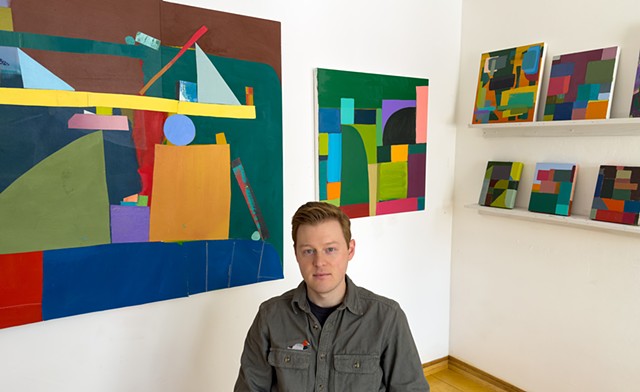About
Biography
Adam Fulwiler is a painter currently based in Sturgeon Bay, WI. His paintings investigate communication, improvisation, and paintings capacity for transformation. He received his BA in painting from the University of Wisconsin - Green Bay ('17) and his MFA in painting from the University of Arkansas ('22). He is a recipient of the 2022 Windgate Foundation Accelerator Grant. He has shown in exhibitions in Arkansas, Wisconsin, Iowa, Tennessee, Ohio, and New York.
Statement
Reflecting on my childhood spent with my brother, who has autism, I establish a painted space that is both forcibly disjointed and meaningfully connected, invoking the uncertainty and complexity of perception and communication. Through chromatic nuance, physicality, representational ambiguity, and visual tempo, I invite the viewer into the act of slow looking—to encounter each work as a living, breathing, individual entity. My paintings investigate communication, improvisation, play, and painting’s capacity for transformation.
When I moved down to Fayetteville in the summer of 2019 to begin my studies, my brother rode along in the moving truck with me. To entertain himself, and as a result, entertain me as well, he created a chart to track multiple objects or types of vehicles found on the highway. Of course, there were the usual license plate states, but he also had items on his lists like trash bags, dead armadillos, furniture, and blown tire debris. He religiously kept records of everything for the entire drive. This tendency is reflected in my invention of tools, games, and puzzles in the studio. Finding ways to reawaken interest in something usually labeled as mundane or create new methods to forcibly slow down the process of making.
Other methods I employ to slow the process or create new opportunities for discovery are the invention of rules and aleatoric devices, mimicking an engagement with board games or puzzles, and pursuing a jazz-like improvisation within these restrictions. The result is an open, scrambled experience of space, like a jigsaw puzzle built from pieces sourced from multiple boxes. Spatial relationships and potential meanings seem to shift with every glance, suggestive of my own experiences reading imaginative and poetic writers like Haruki Murakami and Italo Calvino. Other times, such as the recent “Stack” series, the work explores a palpable sense of gravity. The stacked collaged paintings began to develop after my son and I began playing with blocks, but this idea of stacking has evolved to serve as a representation of both physical and mental weight, fragility, and our ever-changing sense of levelness. The solidity of these stacked paintings is often questionable, which creates a charge of potential energy.
Provisional grids support tessellating blocks of color to create relationships of alternating friction and calm. I sew scraps of work together in a lyrical rhythm reminiscent of quilting, invoking the logic of multiplicity and interconnectivity. Josef Albers observed that color behaves like a human “in two distinct ways: the first in self-realization and then in the realization of relationships with others.” I create paintings to better understand my relationship with my autistic brother and how that experience of growing up has given me a heightened awareness of my sensorial environment, as well as my changed sense of time, play, and perception since becoming a father.
